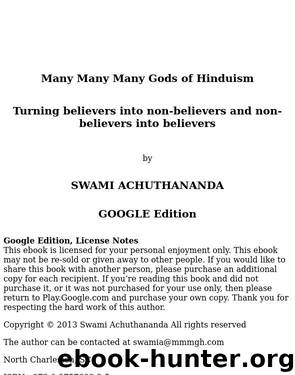Many Many Many Gods of Hinduism by SWAMI ACHUTHANANDA

Author:SWAMI ACHUTHANANDA [ACHUTHANANDA, SWAMI]
Language: eng
Format: epub
Published: 0101-01-01T00:00:00+00:00
The True Self
The Chandogya Upanishad relates the tale of Indra and Virochana, the lords of the devas (gods) and asuras (demons) respectively, who set out to meet Prajapati,19 the lord of the creatures, under the pretext of understanding the meaning of true self. With such enthusiastic, highprofile deities coming from afar, Prajapati was surprised but was more than happy to receive them as his students and impart his knowledge. After thirty years of teaching, Prajapati could no longer hold back his curiosity and demanded in no uncertain terms the real purpose of their scholarship.
“Lord, we both wish to understand the meaning of true self that would provide us immunity from illness and death and lead us to vanquish our enemies, conquer the world, and fulfill all our cherished dreams,” replied his pupils.
Holding a large vessel containing water, Prajapati ordered each of his students to look into the vessel and describe what they see. “Lord, we see the whole of ourselves, even down to our hair and nails,” replied Indra and Virochana in unison.
Prajapati then asked them to put on their finest clothes and look at themselves again in the water. Once again looking at their reflection, “Lord, we see the self, exactly like ourselves, well adorned in our finest clothes,” replied the lords of gods and demons.
And then said Prajapati, “The self is indeed seen in these images. That self is deathless and fearless, and that is the true self.”
While Indra had his doubts, the demon king was completely convinced. Delighted at having found the ultimate insight into the self, Virochana triumphantly returned to the demons and soon formulated what became the guiding principle of the asuras. The body alone is to be served and materialistic pursuit will lead to the ultimate wisdom of the self.
It was only a matter of time for Indra to see through the falsity of the argument. “When the body is well-adorned, the self is well-adorned, but when the body becomes old or lame,” thought Indra, “the self can become old and lame. When the body perishes, the self shall perish too.” It wasn’t too long before Indra returned to his teacher for further inquiry into understanding of the self.
Another thirty-two years passes quickly before Prajapati reveals a further insight: “He who wanders about rejoicing in dreams is indeed the self. That self is deathless and fearless, and that is the true self.”
Once again Indra was quizzical. “True it is,” he said to himself, “that this new self does not become blind if the body is blind, or lame or deformed when the body becomes lame or deformed, but even in dreams the self is conscious of many sufferings. Many have even died from the psychological effects of potent dreams. The self identified with the dreamer cannot be happy all the time.”
So once more Indra returned to Prajapati and stayed with him for another thirty-two years, at the end of which said Prajapati, “When a man is in deep sleep, dreamless and in perfect peace, he realizes the self.
Download
This site does not store any files on its server. We only index and link to content provided by other sites. Please contact the content providers to delete copyright contents if any and email us, we'll remove relevant links or contents immediately.
The Lost Art of Listening by Michael P. Nichols(7169)
Why I Am Not A Calvinist by Dr. Peter S. Ruckman(4048)
The Rosicrucians by Christopher McIntosh(3373)
Wicca: a guide for the solitary practitioner by Scott Cunningham(3045)
Signature in the Cell: DNA and the Evidence for Intelligent Design by Stephen C. Meyer(2879)
Real Sex by Lauren F. Winner(2869)
The Holy Spirit by Billy Graham(2779)
To Light a Sacred Flame by Silver RavenWolf(2680)
The End of Faith by Sam Harris(2637)
The Gnostic Gospels by Pagels Elaine(2400)
Waking Up by Sam Harris(2332)
Nine Parts of Desire by Geraldine Brooks(2283)
Jesus by Paul Johnson(2230)
Devil, The by Almond Philip C(2207)
The God delusion by Richard Dawkins(2192)
Heavens on Earth by Michael Shermer(2190)
Kundalini by Gopi Krishna(2094)
Chosen by God by R. C. Sproul(2057)
The Nature of Consciousness by Rupert Spira(1983)
